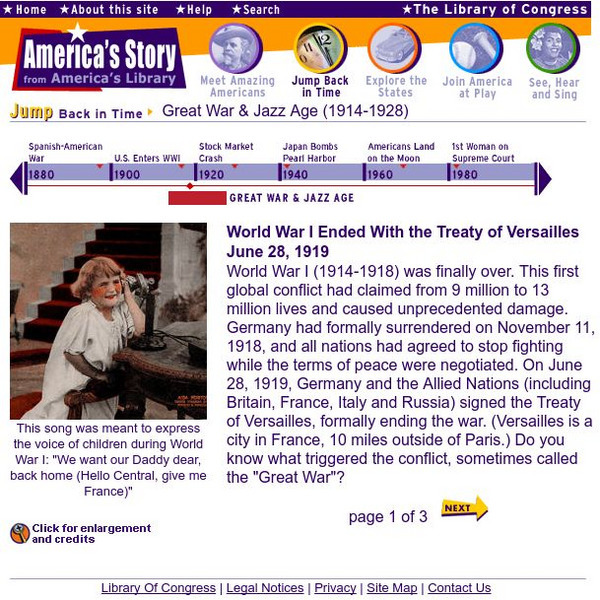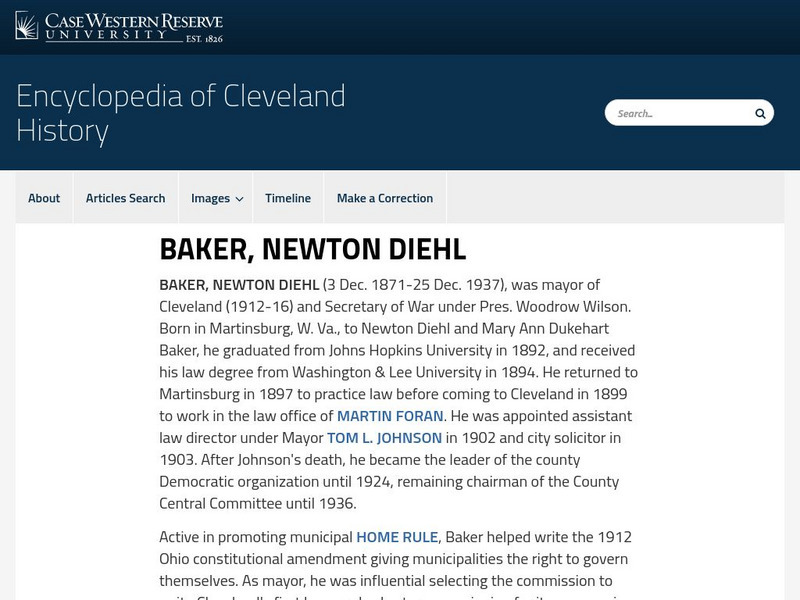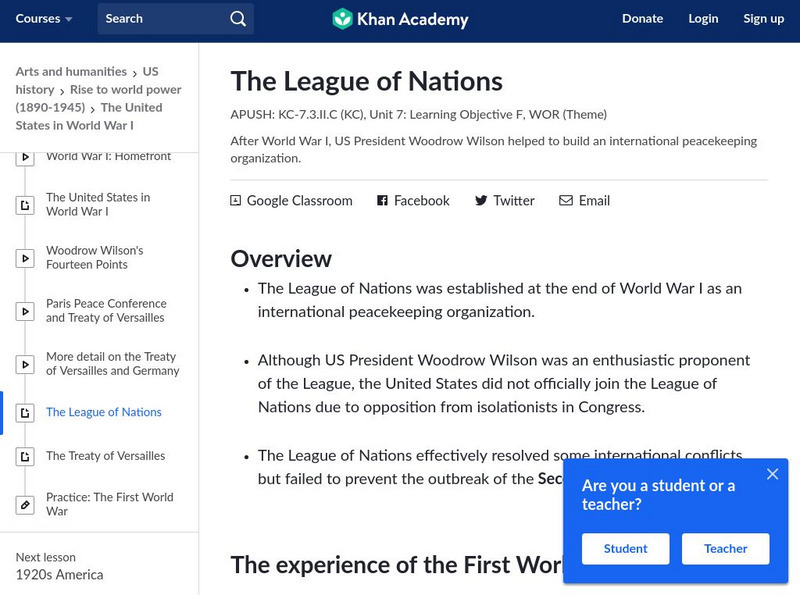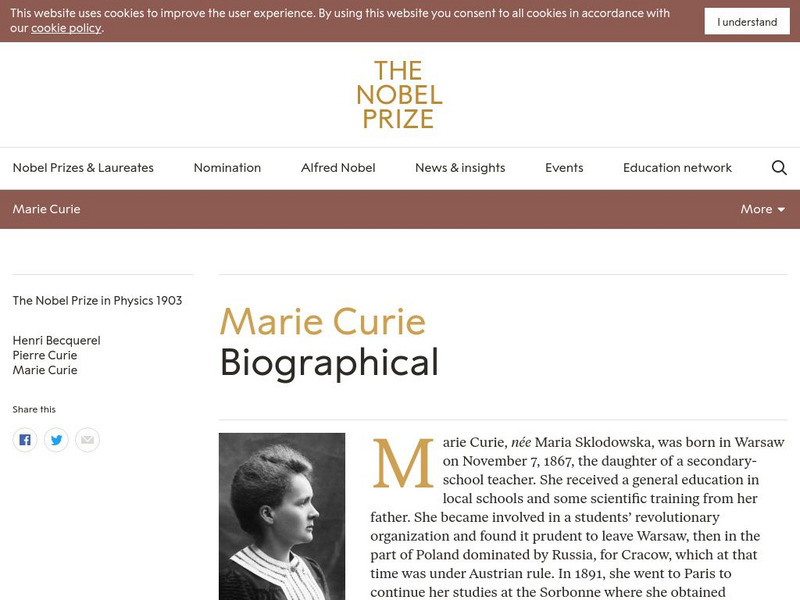Read Works
Read Works: World War I & the Great Depression the League of Nations
[Free Registration/Login Required] An informational about the League of Nations during World War I. A question sheet is available to help students build skills in reading comprehension.
Library of Congress
Loc: America's Story: Woodrow Wilson
President Woodrow Wilson had more than his share of difficulties during his term in office. The Library of Congress has a site with information, authentic pictures, and video.
Library of Congress
Loc: America's Story: Ww I Ended, Treaty of Versailles
This site describes how the Treaty of Versailles ended World War I. Includes photos.
A&E Television
History.com: Joseph Stalin
The History Channel provides a biographical look at the Russian dictator Joseph Stalin, beginning with his early career, rise to power, time as a Soviet leader, and the partial dismantling of his police state in the years after his death.
Nobel Media AB
The Nobel Prize: The Nobel Peace Prize 1919: Woodrow Wilson Facts
This site from the Nobel eMuseum allows you to read about Woodrow Wilson's (1856-1924) peacemaking actions for which he was honored with the Nobel Peace Prize in 1919. This website provides both primary and secondary texts and includes...
Other
Encyclopedia of Cleveland History:baker, Newton Diehl
A brief biography of Newton Diehl Baker, activist mayor of Cleveland, and Woodrow Wilson's secretary of War during World War I.
Tom Richey
Tom Richey: World War I for u.s. History
This slideshow will explore the reasons the United States joined into fighting during World War I. Explore the role Woodrow Wilson had during the war, the Treaty of Versailles, and the creation of the League of Nations.
Khan Academy
Khan Academy: Ap Us History: 1890 1945: The Us in Wwi: The League of Nations
Discusses the background to establishing the League of Nations, its role in facilitating peace negotiations, and why it ultimately failed to prevent World War II. Explains why the United States never joined it and how the United Nations...
PBS
Wnet: Thirteen: Freedom: History of Us: Safe for Democracy?: Wilson's 14 Points [Pdf]
A lesson plan from the producers of the 16-episode PBS series "Freedom: A History of US" that directs students to examine Woodrow Wilson's Fourteen Points. They will discuss how Wilson's plan and the establishment of the League of...
Independence Hall Association
U.s. History: The Treaty of Versailles and the League of Nations
President Wilson lobbied for a "just peace" for the end of World War I. Read about his Fourteen Points that he thought would accomplish this. See how his plans for a League of Nations and the final terms of the Treaty of Versailles...
The History Cat
The History Cat: Treaty of Versailles: Peace Returns
Describes what happened at the end of World War I - the celebrations and the unnecessary final battles - as the Big Four (France, Britain, the United States, and Italy) sat down to begin negotiations for the Treaty of Versailles....
The History Cat
The History Cat: America Enters the Ring
Describes the events leading up to America's entry into World War I and the changes that took place in America soon after. These included legislation such as the Selective Service Act and the Espionage and Sedition Acts, protests by...
CommonLit
Common Lit: Book Pairings: "The Remains of the Day" by Kazuo Ishiguro
Selected (9) reading passages (grades 9-11) to pair with "The Remains of the Day" by Kazuo Ishiguro. After decades of striving to be the perfect butler, Stevens embarks on a drive through postwar England that prompts him to reflect on...
CommonLit
Common Lit: Text Sets: World War I
World War I, or the Great War, embroiled the globe in bloody fighting from 1914 to 1918. Learn about the complex alliances that led dozens of countries to go to war, how the war was won, and what life was like for soldiers and civilians....
Nobel Media AB
The Nobel Prize: Marie Curie Biographical
This site from the Nobel eMuseum from the Nobel Foundation provides information for you to read about the life and scientific discoveries of Marie Curie (1867-1934 CE), whose work with radioactivity earned her two Nobel Prizes.
Khan Academy
Khan Academy: Us History: 1890 1945: The League of Nations
After World War I, US President Woodrow Wilson helped to build an international peacekeeping organization.
Other
League of Nations: 1920 1946 Map
A color-coded map from Matthew White's Homepage showing which countries were a part of the League of Nations during specific times in history.
Other
Human Rights Web: Charter of the United Nations
At this website, read the complete text of the Charter of the United Nations.
The White House
The White House: Presidents: Warren G. Harding
This site, which is provided for by the White House, gives a short biography of Warren G Harding's life and presidency.
Nobel Media AB
The Nobel Prize: Gustav Stresemann Nobel Lecture: The New Germany
This site from the Nobel Foundation provides the opportunity to read Gustav Stresemann's Nobel Lecture, entitled "The New Germany." The speech, originally given June 29, 1927, is annotated with footnotes.
Ohio State University
E History: Covenant of the League of Nations
From John Clark Ridpath's History of the World, this page offers the Covenant of the League of Nations. This is the official document that the League of Nations used as a charter.
Siteseen
Siteseen: American Historama: Fourteen Points
Comprehensive resource provides interesting facts about Wilson's speech that contained 14 points for a peaceful settlement of WW1.
Ducksters
Ducksters: World War I for Kids: End of Wwi and Post War
Kids learn about the history of what happened after World War I including the armistice, negotiations, the Big Four, the Treaty of Versailles, and the League of Nations.



















